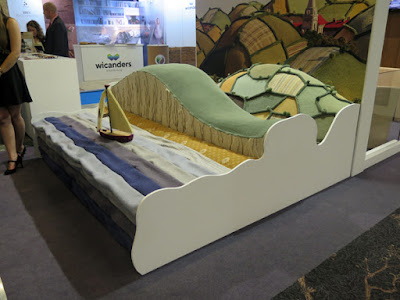When planning the weekend away to Knaresborough, it was always my intention to visit on the same weekend as The Flooring Show, a national trade exhibition held annually at the Harrogate Convention Centre. Although I had only a passing interest in this event, to see if there were any potential uses of my Glowing Edges Designs for rugs and carpets, I mainly wanted to have a good long wander around Harrogate.
 |
| Bettys Cafe Tea Rooms |
Very many years ago, I drove through this old spa town and noticed that it contained numerous large and ornate Victorian buildings and I was interested in having a closer look. Being dropped off at Harrogate railway station with my travel bag, I only had a fleeting look at some of the buildings on the way to and around the convention centre, but it was enough to give me an introduction to its building stones.
 |
| The geology of the area around Harrogate |
Most of the low lying old town centre is built on the Bowland Shale – potentially the source of shale gas by the controversial process of fracking - but the area surrounding Harrogate is formed from the Millstone Grit Group, which is usually a source of good quality building stone; however, in this part of Yorkshire and further north, the Yoredale Group forms a very distinct local variation in the character of these Carboniferous rocks, with limestone alternating with siliceous rocks.
 |
| The Wesley Chapel in Harrogate |
I didn’t get the opportunity to examine any of the buildings closely using my hand lens and other geologist's tools that I had with me - to determine the physical characteristics of the stones - but buff/brown sandstone is ubiquitous in the historic buildings of Harrogate.
 |
| The Victoria Shopping Centre |
Opposite the railway station, the Victoria Shopping Centre, built in 1992 by architects Cullearn & Phillips in a Palladian style, caught my eye – not least for the statues at parapet level and the colour of the stone, which is distinctly orange/red in places and not typical of those normally quarried from the Millstone Grit.
 |
| The Jubilee Memorial |
The ornate sandstone Jubilee Memorial of 1887, with a Portland limestone statue of Queen Victoria, is very impressive and makes use of Scottish grey and pink granite in its columns – materials that were widely used in the late 19th century, but are now generally unobtainable and difficult to match.
 |
| A relief sculpture on Harrogate War Memorial |
Another use of Portland stone can be seen in the Harrogate War Memorial, but around Low Harrogate, where the original spa town grew around the various springs that are found here, sandstone dominates the historic architecture.
Although I had no opportunity to closely examine them, the large monumental buildings such as the Royal Baths and the Royal Hall appear to be built of stone with a uniform colour but commercial parades and the less ornate buildings have greater orange/brown colour variation.
I have never had a reason to professionally investigate the geology and building stones of North Yorkshire, and haven't visited any quarries there, but I suspect that the grand buildings have used sandstone from West Yorkshire – given its reputation for producing durable stone - and those of lesser importance have used the cheaper stone from nearby.
Like Buxton in the Peak District, although it would take a long day out to get there and back by public transport, I think that I could easily spend a few hours exploring its historic architecture - as well as its green spaces - and I look forward to visiting Harrogate again.
 |
| Cheltenham Parade in Harrogate |
I have never had a reason to professionally investigate the geology and building stones of North Yorkshire, and haven't visited any quarries there, but I suspect that the grand buildings have used sandstone from West Yorkshire – given its reputation for producing durable stone - and those of lesser importance have used the cheaper stone from nearby.
 |
| The Royal Baths in Harrogate |
Like Buxton in the Peak District, although it would take a long day out to get there and back by public transport, I think that I could easily spend a few hours exploring its historic architecture - as well as its green spaces - and I look forward to visiting Harrogate again.



No comments:
Post a Comment